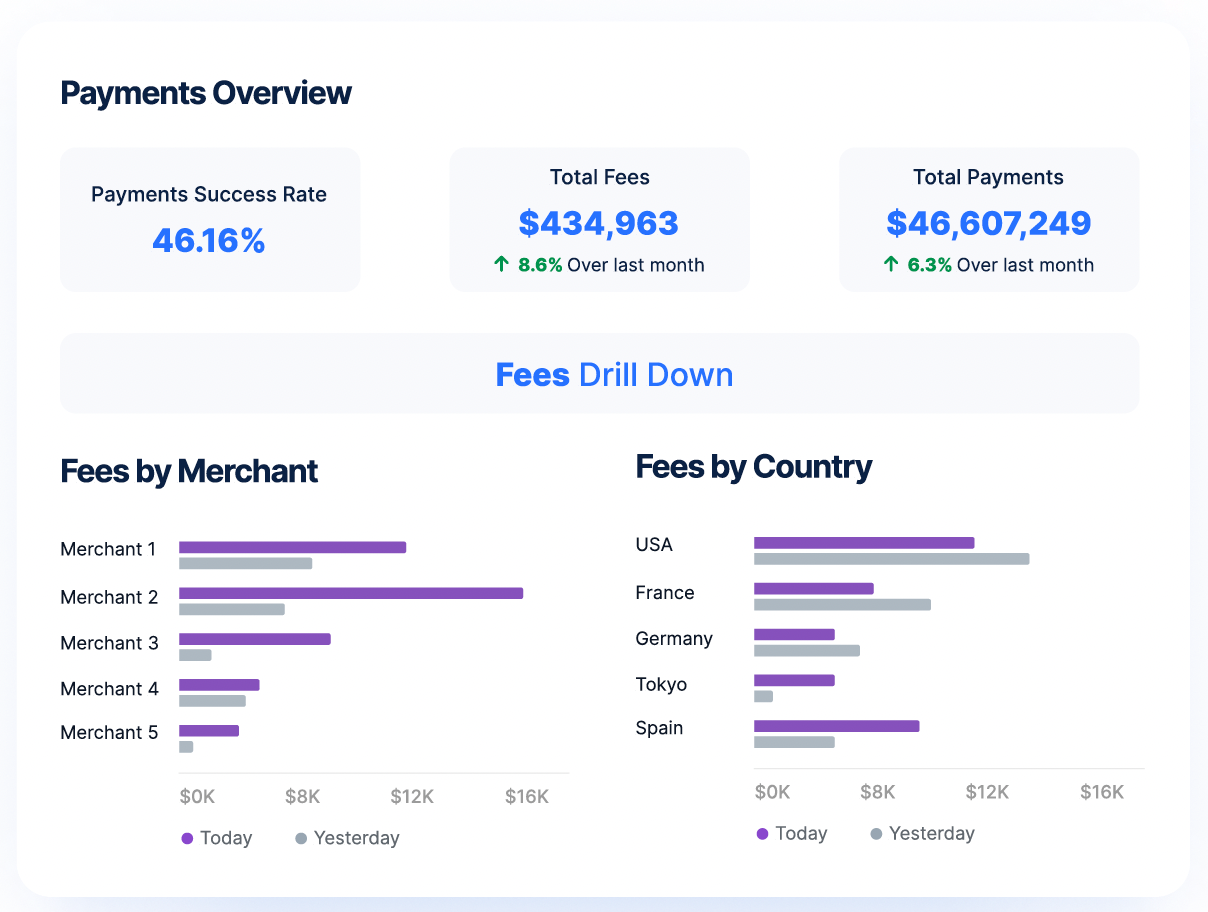In today’s payments ecosystem, the ability to monitor and use payment data effectively represents a real and essential competitive advantage. Intelligent operations should be a strategic goal for the entire company, and when executed properly, will enable you to build a future-proof payment operations infrastructure.
With the increased proliferation of AI technologies, the payment operations space has been fundamentally changed, and the traditional legacy BI approach relying on dashboards and static thresholds is no longer adequate. AI and ML are critical to accelerating revenue, improving operational efficiency, and providing better customer experiences. Global payments leaders are increasingly relying on AI to monitor and optimize their payment operations resulting in lower costs, higher approval rates, and fewer declined transactions.
In this White Paper: The Journey to Intelligent Payment Operations we define five levels of payment operations maturity, with Level 1 being the least mature and Level 5 employing the most advanced practices: As we advance through levels, we consider 3 key characteristics: monitoring, operations and data; define the key metrics and dimensions we measure; and offer suggestions for how to level up. Additionally, we asked our Chief Data Officer, Dr. Ira Cohen, to share his insights on improving monitoring effectiveness no matter your maturity level or platform.
Level 1 : Responders — Analytics and BI
At this level, organizations are highly reactive. They operate based on dashboards and static alerts, relying on non-standardized and fragmented manual processes using email and spreadsheets — neglecting advanced tools and leading practices that drive operational performance and resilience.
Level 1 companies are focused only on the most basic aspects of monitoring — using dashboards that are monitored visually and alerts based on manual static thresholds that result in alert noise, false positives and false negatives.
Tips from our CDO
- When integrating to a vendor – Implement all APIs provided by them — including those not relevant to initiating transactions.
- Establish your KPIs in simple bullet points (e.g., increase payment acceptance) and understand your most influential dimensions.
- Eliminate noise by grouping values of dimensions that may affect the results but do not affect the business
- Measure the impact! Make sure you’re monitoring business vs. technical stuff — you might see a glitch, but the impact is minimal.
- Understand your seasonality and incorporate special events into your monitoring systems
Level 2 : Guardians — Automated Anomaly Detection
Level 2 organizations have developed more proactive and collaborative processes, incorporating AI- and especially Machine Learning-based technologies to drive operational speed and agility. They implement a robust anomaly detection system which serves as the gatekeeper of their business and the frontline protector of their customers and revenue.
AI-based anomaly detection provides financial institutions with the capabilities needed to detect issues early and take preemptive actions before they turn into crises. They do so by automatically learning the data’s normal behavior, including seasonal and other complex patterns, to identify and alert stakeholders on any combination of metrics that behave abnormally.
Operations teams in Level 2 companies can send any data stream for monitoring, which will be continually analyzed for anomalies. Instead of looking at dashboards, they monitor for anomalies and use AI-based scoring to triage and resolve issues according to their severity and impact.
Tip from our CDO
- Avoid false positives in KPIs that are ratios (e.g., payment success rate) by augmenting with logic that also looks at the volume behind the ratio (e.g., # of payment attempts). Not doing so will alert the team frequently at night, when payment volumes are low and the ratio fluctuates.
Level 3 : Analysts — Automated Correlation
Correlation is a marquee trait for Level 3 organizations. They have moved beyond basic single metric/stream anomaly detection and have a comprehensive view of their business and incident impact with event and anomaly correlations.
Applying anomaly detection on all metrics and surfacing correlated anomalous metrics helps draw relationships that not only reduce time to detection (TTD) but also support shortened time to remediation (TTR). This frees up both data professionals and their operations counterparts to collaborate on automation initiatives, simplify complex internal operating structures, and enable support of more complex payment ecosystems.
Tips from our CDO
- Slow drifts are typically detectable only at higher time scales (e.g., daily/weekly). If the payment success rate slowly declines because of a small glitch for a few transactions, it would be hard to notice at lower time scales (e.g., minutes/hours).
- Monitor high level KPIs (e.g., payments) at lower time scales and more granular breakdowns of the KPI (e.g., payments by country, gateway, provider, merchant, etc.) at a higher timescale. More granularity results in very low volumes of payments for some combinations — making it nearly impossible to detect issues. For example, if the number of payments for a merchant in a certain country using a specific gateway is very low for a time scale (e.g., 1 payment per hour on average), detecting drops in payments and success rates at minute and even hourly time scales will be very hard. But at a daily time scale, the volume will be high enough to detect meaningful drops.
Level 4 : Masters — Augmented Root Cause Analysis
Organizations at this level are masters of payment operations. Payment operations are automated across the board using AI. They have sophisticated practices and tools in place for detection, correlation, incident triage, and remediation. In these companies, data professionals and operations are focusing on judgment-based work and are empowered to deal with high value activities such as business strategy, product development, and advanced analytics.
For Level 4 companies to reach the upper echelon of Level 5, they have to make remediation core to their payment operations strategy. The good news is they have all the pieces in place: a centralized monitoring platform; autonomous learning of data at scale; accurate learning models; event and anomaly correlation; noise reduction mechanisms; and support for quick root cause analysis.
Tip from our CDO
- For KPIs with low volumes, monitor the time between transactions and detect when it becomes too long compared to normal. This provides the ability to detect failures in very low volume KPIs.
Level 5 : Visionaries — Automated Remediation
Level 5 companies are robust in all dimensions of payment operations maturity, but what really separates them from others is their journey to automated remediation. They codified their remediation strategies using webhooks and triage workflows to enable automated remediation. As a result, teams at Level 5 companies can identify and fix challenges more efficiently, resulting in improved customer experience and much lower incident costs.
With the competitive edge and agility offered by their intelligent operations, Level 5 companies outperform and outpace their less mature counterparts. The journey to level 5 isn’t straightforward, nor is it the same for everyone. So regardless of your current level, you need to pay attention to the Level 5s to understand the challenges coming your way.
Tip from our CDO
- ML-based monitoring is paving the way for autonomous remediation. Soon, ML-based systems will recommend a remediation action based on previous incidents; execute the action through the remediation engine, and fine tune its operations through a closed feedback loop, increasingly improving its reactions. The promise is exciting, but the reality is complicated. Learn more about the route to automated remediation and the eight essential components that automated remediation will depend on to (hopefully) operate successfully.
Leapfrog maturity levels with Anodot
Anodot’s autonomous business monitoring platform helps merchants and payment providers to identify and resolve payment issues faster, route payments intelligently, and optimize approval rates.
Anodot customers report 80% faster detection times, 90% drop in alert noise, and 30% reduction in incident costs. By optimizing the payment transaction process, their operations teams can focus their efforts on digital transformation and value-added initiatives.
Payments Operations Business Package
Anodot, working with major fintech clients, has developed a turn-key monitoring solution for payment operations teams, utilizing industry best practices and ML domain expertise.

Anodot’s payment monitoring business package is built to deliver value fast:
- Easy integration to any payment data source.
- Out-of-the-box alerts and dashboards.
- Completely autonomous learning, monitoring, and correlations.
- Slick and simple UI makes root cause investigation a breeze.
- Triage workflows and automated actions.
Payment companies and financial institutions can quickly expand their monitoring coverage with additional business packages offered by Anodot:
- Customer Experience & Support — Monitoring users impressions, funnel, Customer support events, calls, chats and emails.
- Treasury & FX — Monitoring deposits, accounts balances, fluctuations,
- Fraud — Monitoring trends, anomalies and suspicious behavior




